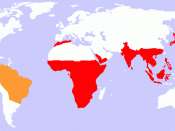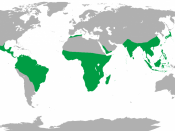Familial Relationships 2
Borgmeyer
Similarities in Human and Nonhuman Primates: Familial Relationships.
There have been thousands of research projects concerning socio-cultural experiments and interpretations. Due to this, observations have been recorded on social and family groups within the human primate and non-human primate society; as well as the similarities between them and the deviant, aberrant behavior patterns that result.
In the smaller primates there are 2 major classes of monkey--Old World, which are tree dwellers and will regularly come down from the treetops to forage for food and have cheek pouches for carrying it, and New World monkeys who show sexual dimorphism.
Old World monkeys have pads for sitting called ischial callosities and have a more opposable thumb than the New World monkeys. New World monkeys are the only group that has a prehensile tail. Old World monkeys will be the primary focus of the forthcoming information.
Primary Groups
The art of communication isn't just in the realm of human apes.
Human apes, otherwise known as human beings, regularly enforce and execute the activities of primary and secondary groups. In human activity primary groups are formed through common beliefs and values and as Bussierre (1999) defines it "Primary Groups: small social group whose members share personal and enduring relationships." Although others such as Cooley; famous for building upon the sociological works of William James has defined Primary Groups in this manner: "I mean those characterized by intimate face-to-face association and cooperation. They are primary in several senses but chiefly in that they are fundamental in forming the social nature and ideals of individuals. The result of intimate association, psychologically, is a certain fusion of individualities in a common whole, so that one's very self, for many purposes at least, is the common life and purpose of the group. Perhaps...


